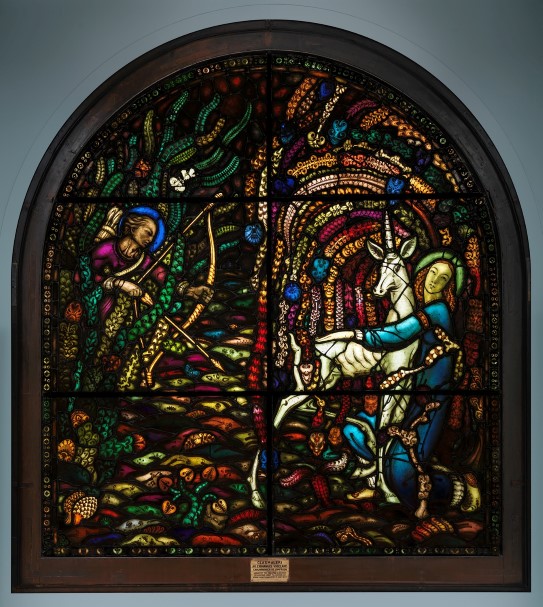Stained glass window, The virgin and unicorn
Emanuel Vigeland
Transcription
Narrator:
In a lush landscape, a virgin kneels with her arms around a frightened creature, a unicorn. A hunter storms out of the thicket on her right.
The unicorn seeking the virgin’s protection looks as though it’s been plucked from the fantasy literature of our own times — an Arthurian adventure about a mythical creature with a horn on its forehead and magical powers.
Over the years, Emmanuel Vigeland’s stained-glass artwork had become darkened by dirt, soot, and heating fumes.
To bring them back to life, the panels were taken down and restored. Maren Midtdal, an object conservator at the National Museum explains:
Conservator Maren Midtdal:
In collaboration with Elisabeth Sinnerud and Henning Grøtt, who are both technicians working on the restoration of Nidaros Cathedral in Trondheim, we cleaned the glass piece by piece, using cotton buds dipped in deionized water and acetone. This removed a century of dust and soot and revealed Emmanuel Vigeland’s original colours.
And particularly when the glass panels are set against a new source of illumination, one sees how it suddenly explodes with colour!
Narrator:
The stained-glass artwork was commissioned to celebrate the birthday of the director of the Norwegian Museum of Decorative Arts and Design. The completed artwork was installed in July 1923.
Conservator Maren Midtdal:
This work had been on the staircase of the Museum of Decorative Arts and Design ever since I joined the museum, and I had passed it almost every day. But it’s something quite different when you’ve been really close to it and worked on it over a period of time, smelled it, cleaned it, seen how things emerge and kind of become its friend. Suddenly there are tiny details that one’s never seen before. And seeing it now with the correct illumination, with the correct colours as Vigeland would have wanted us to see it, that’s really a privilege.
Just as it’s a privilege every day to be allowed to be close to art while doing one’s job as a conservator.